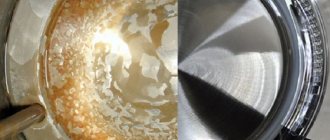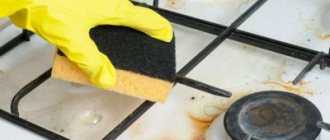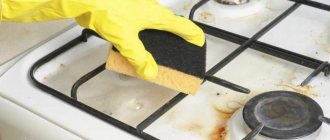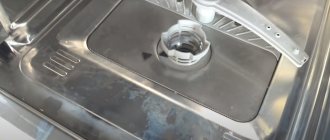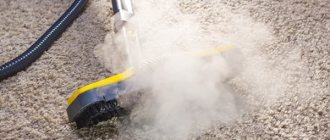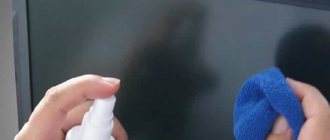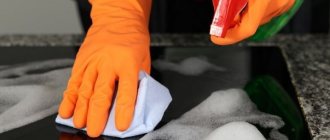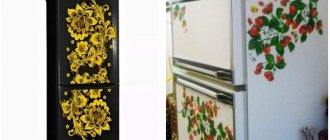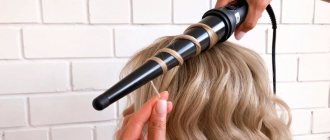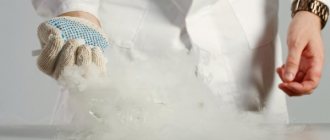Burning of fabric to the soleplate of the iron occurs quite often. Owners of even the latest modern models of irons are not immune to this problem. Most often, trouble occurs as a result of incorrect temperature adjustment. There are many ways to clean the device. The procedure can be carried out using folk recipes or ready-made store products. But to get the most effective results, you need to know the general rules for cleaning the soleplate of any type of iron.
General cleaning rules
When removing contamination, you should choose methods that are suitable for a specific iron model. However, there are general recommendations for performing the procedure.
Whatever material the sole is made of, you should remember that cleaning it with metal and sharp objects is strictly prohibited. For example, scissors or hard brushes. You cannot use sandpaper either. Otherwise, scratches will form on the surface of the sole, which will subsequently be impossible to get rid of.
If the procedure is carried out using a chemical agent, after completion it is necessary to wipe the device with a damp cloth. If you do not wipe off any remaining cleaning product in a timely manner, there is a risk of damaging your clothes during subsequent ironing.
It is better to clean the surface on the balcony or in a room with open windows. When using chemicals, you must wear a special mask.
If there are fragments of stuck fabric on the surface, you need to remove them with a cotton swab dipped in vinegar.
Universal means
For various types of soles, the chemical industry produces special products for cleaning iron from burnt marks, which can completely clean the surface of contaminants. The most popular are pencils, similar in shape to paraffin candles. Each pencil comes with instructions that indicate what material can be cleaned with it. Before the procedure, the electric iron must be heated to medium temperature.
Cleaning your iron with a pencil is very easy
During application, the pencil melts, and the resulting liquid absorbs the burnt residue. After 2-3 minutes, the dirt is removed from the still hot sole with a damp cloth, and then the cleaned area is wiped dry with a dry rag.
When using a pencil to remove dirt, ensure the room is ventilated and wear a mask, as the product contains substances harmful to health.
Cleaning irons with Teflon and ceramic coatings
Teflon and ceramic coatings are made for modern iron models. The rules for cleaning such coatings are approximately the same. Irons with Teflon coating are good because they heat up to maximum temperature in a short time, and also glide smoothly over the surface of the fabric when ironing. However, such devices require regular maintenance. Otherwise, the device ceases to perform its functions efficiently.
The Teflon sole can be cleaned using chemicals or folk recipes. Most often used:
- Special pencils that help soften plaque.
- Store-bought cleaning products.
- Vinegar.
- Wax.
- Hydrogen peroxide.
Mandatory rule: wipe the surface with a rag or napkin at the end of the procedure.
Expert opinion
Sofia Kovalevskaya
Experienced housewife.
Ask me a question
Ceramic soles can be easily cleaned at home, but also require careful use and proper care. For ceramic surfaces, special glass ceramic cleaning products, sold in specialized stores, are suitable. The procedure is performed using a sponge suitable for non-stick bases.
For home cleaning, use:
- Lemon acid.
- Ammonia.
- Vinegar.
During procedures, it is recommended to carefully walk over the surface to prevent scratches.
How to clean different types of coating?
Teflon
The material prevents the fabric from sticking; however, during ironing, it sometimes happens that carbon deposits form on the iron.
Do not start scraping off the dirt with a knife - the Teflon layer is very easily damaged, which will lead to damage to the device.
A suitable option for cleaning the ironing platform is a pencil.
You can also use home remedies:
- Soak a piece of fabric in vinegar essence (70%) and iron the fabric with a well-heated iron. Be sure to protect your hands with rubber gloves and try not to lean over the caustic steam generated during ironing. After removing stains, wipe the surface of the platform with water.
- Soak a cotton pad with household painting solvent and remove the carbon deposits (the iron should be cold), wipe the soleplate with a damp cloth.
Aluminum
The material has high thermal conductivity, but is very soft, so this ironing platform cannot be cleaned with abrasives.
In addition to ready-made chemical products (pencils), you can clean the iron in the following ways:
- Apply a thick layer of toothpaste to the cold sole, carefully spread the product with a brush over the entire area of dirt and leave for 15-20 minutes. Wipe the stains with a damp sponge and remove any remaining paste. To clean the holes, turn on the iron and iron the fabric using a few bursts of steam.
- Place a piece of foil on the ironing board and smooth it out. Turn the iron on to maximum and walk over the metal sheet several times - the stuck fabric will come away from the sole. Wipe the cooled device with a damp sponge.
Ceramic
Ceramic is easy to care for and durable, but even a small scratch on the sole can cause the coating to peel off.
Cleaning agents for the ceramic platform should not contain abrasive particles and alkalis:
- remove large pieces of carbon deposits with a wooden kitchen spatula;
- Mix 10 ml of table vinegar and 30 ml of warm water in a small container, soak a cloth in the solution and wipe the area with stuck synthetics. You can use a nylon washcloth.
The stick product is excellent for cleaning ceramic surfaces.
Steel
The material of the sole is durable and resistant to mechanical damage , so they can be cleaned using gentle abrasives: soda, salt or tooth powder.
Cleaning irons with metal coating
Rules for cleaning metal coatings depend on the specific material. Metal bases are made of steel and aluminum. The steel surface is good because it has sufficient strength and good glide over the fabric. In addition, it is easy to clean. Common means to combat carbon deposits on steel soles:
- Soda.
- Toothpaste.
- Lemon acid.
The easiest option is to use laundry soap; this method was used back in the last century. However, soap can clog the special holes, making it difficult to release steam. You can also get rid of carbon deposits using a wooden spatula, however, you must ensure that scratches do not form on the coating.
Irons with aluminum soles are known as the most inexpensive devices. But the price usually corresponds to the quality, and careful and regular maintenance is required to keep such an iron performing well. Aluminum soles are unstable and brittle; they quickly become scratched and most often develop carbon deposits. To clean the aluminum surface, the use of hard brushes and sponges is not allowed. It is possible to remove stains using special pencils, soda or vinegar.
Important! It is forbidden to use citric acid on aluminum, otherwise the metal surface will likely be destroyed.
Electric iron sole materials
Various materials are used to make the working surfaces of ironing devices. Some people burn often, while with others such troubles happen less often. Depending on the alloys used, methods for their purification are also selected.
Stainless steel and aluminum
Stainless steel and aluminum alloy are used in budget models. Polished steel has good strength, it is durable and does not scratch. But this material is quite heavy and takes a long time to heat up and cool down. Another drawback is that the fabric quickly sticks to it if the ironing mode is chosen incorrectly and the sole temperature is even slightly higher than required. Polished steel surfaces can be cleaned with abrasives such as salt.
Polished stainless steel and anodized aluminum ironing surfaces
This cleaning method is not suitable for anodized aluminum, because this material is easily scratched. It is susceptible to burning in the same way as stainless steel, so the aluminum surface will also have to be cleaned frequently.
Ceramics and Teflon
These materials burn much less often, but their main drawback is fragility. The ceramic coating is susceptible to chips and scratches. Teflon is a polymer that is not durable and is subject to wear. While ceramic and more durable metal-ceramic coatings glide very well over fabrics, the same cannot be said about Teflon soles.
The most common iron soles, including ceramic and Teflon
Ceramic and Teflon are much easier and faster to clean than stainless steel and aluminum. But you cannot scrape off burnt marks and use abrasive materials to clean them.
Titanium and sapphire
These alloys are used for coating the working surfaces of expensive models of electric irons. Titanium is a durable material, so a device with such a working surface will last a very long time. True, the titanium layer has lower thermal conductivity than the materials described above. This means that the energy consumption for heating the titanium sole will be high.
Iron with titanium coating
Sapphire mineral chips are also very resistant to mechanical stress. Therefore, it is permissible to clean these surfaces even with metal brushes. The same method can be applied to titanium soles.
Saphir sole of Braun TexStyle 7 iron
Popular ways to clean an iron from burnt fabric
Sticky fabric must be removed from the surface using a method depending on the coating of the iron. Today, on the shelves of hardware stores there are many products suitable for cleaning any surface. The most budget option is special pencils or crayons. Homemade products are equally common, such as vinegar, soda, citric acid or toothpaste.
Special pencils and tools
Cleaning sticks are considered a universal tool and are suitable for cleaning surfaces made of any materials, especially if there is stuck fabric. In addition, pencils are attractive due to their cost. The average price of a product is 50 rubles, but the amount may vary depending on the manufacturer’s brand. You can buy a pencil in hardware stores or online.
The good thing about the product is that it does not contain abrasives, which makes it unlikely that scratches and cracks will appear on the sole. Some pencils can not only remove elements of burnt fabric, but also remove scale from the surface. One of the disadvantages is the unpleasant odor of the product, which intensifies during the cleaning process. Therefore, it is recommended to open the windows during the procedure. To achieve the desired result, you need:
- Preheat the iron to its highest temperature.
- Slightly tilt the device and walk the pencil over the contaminated areas. The cleaning element will begin to melt and flow down. At this moment, you should take safety precautions, otherwise a burn may occur. You don't need to press hard on the pencil.
- Wait until the iron cools down; to do this, you can take it out onto the balcony.
- Remove any particles of product with a cloth or napkin.
- Before using the device, it is recommended to first walk on the cotton surface.
If the deposit has not completely disappeared, it is recommended to repeat the procedure again.
To clean ceramic soles, you can use special products for glass ceramics. For the procedure, you will need to warm up the iron, apply the product to the sole, wait a little, and wash off the residue with a rag or napkin.
Home methods
You can remove carbon deposits from the soleplate of an iron with many household products that are available in the arsenal of almost any housewife. The most common options are hydrogen peroxide, citric acid, soda, and salt.
To perform the procedure using peroxide, you need:
- Take a cotton pad and soak it generously in peroxide.
- Wipe the soleplate of the iron.
- Wipe off any residue with a damp cloth.
There is no need to heat the iron during the process.
Cleaning with citric acid gives an effective result that is no different from store-bought products. To complete the procedure, you should follow the instructions:
- Add a spoonful of citric acid to a glass of cold water.
- Stir the solution.
- Pour it into a special liquid reservoir.
- Activate the steam release function.
- Repeat the steps several times.
Next, let the iron cool and wipe the soleplate with a cloth.
To remove carbon deposits using baking soda you will need:
- Heat the device to the highest temperature.
- Wrap a few spoons of soda in a bandage or gauze.
- Go through problem areas.
When finished, let the iron cool and wipe the soleplate with a rag or napkin.
To carry out the procedure using salt, you will need:
- Spread a cotton cloth on a hard surface.
- Pour a glass of salt onto it.
- Heat the iron and walk over the cloth with salt.
- Continue until the salt turns brown.
Allow the iron to cool and wipe the cleaned area with a cloth.
How to prevent scorch formation
The coating ensures efficient ironing, so the sole must have an ideal appearance. Proper handling of equipment is the key to its long-term operation. If treated with care, the device will last a long time in the household. To protect your iron from burning, it is worth remembering several important rules when operating the device.
- Observe the ironing temperature and pay attention to the information on the labels. Some devices have separate modes for delicate, cotton and synthetic fabrics.
- Iron clothes made of delicate fabrics through gauze. Many manufacturers supply thin metal pads with the device. This will protect both the fabric from scorching and the surface of the household appliance from burning.
- Do not iron on carpet. If you haven’t had time to get a special ironing board, be sure to put cotton material under your clothes.
- It is much easier to wash a slightly dirty iron than to then try to scrub off a heavily scorched surface.
- Do not forget to take preventive measures by removing minor burnt marks. This will help get rid of the accumulation of sticky fibers at the initial stage.
Let's summarize: What are the most effective means for cleaning iron from burnt marks? Both folk remedies are popular due to their availability and availability in the household, as well as special ones. Each method presented will give a positive result if you take into account the type and strength of the sole when choosing.
Preventing the formation of burning marks
Problems with carbon deposits can be avoided if you follow some rules and regularly monitor the device. Even modern models of irons with non-stick coatings require careful care.
To eliminate problems you should:
- Carefully select the temperature for a specific fabric material.
- Perform the ironing process only on a stable and hard surface.
- Add clean water that has passed through a filter or boiled into the liquid reservoir.
- Don't forget to throw away any remaining water after ironing.
- After each ironing, wipe the soleplate of the iron with a napkin.
- Clean the device regularly.
- Try to iron synthetic fabrics through gauze.
- If fragments of tissue appear on the sole, remove them with a cotton swab dipped in hydrogen peroxide.
Important! If carbon deposits do form, it is better not to use the iron for ironing, but to clean it thoroughly. Otherwise, the contaminated sole will leave dirty marks on it when it comes into contact with the fabric.
Prevention of soot
It is easier to prevent a problem than to fix it.
- In order not to think about how to clean the iron from carbon deposits, you need to turn it on at the temperature that is suitable for the material.
- I recommend sorting your clothes by fabric type.
- Start ironing delicate items at a low temperature.
- To prevent shiny marks from appearing on the material, it is better to run a hot iron over dark items from the wrong side.
- To prevent the iron from burning, linen and cotton should be ironed damp.
- If things are already dry, just spray them with a small amount of water.
- Silk is also good to process while it is not completely dry.
- Moderate temperatures must also be observed for synthetics.
Many clothing manufacturers leave ironing recommendations on their labels. The temperature and method of heat treatment are indicated there. It is advisable not to ignore such advice in order to maintain the attractive appearance of your clothes and preserve your household appliance.

